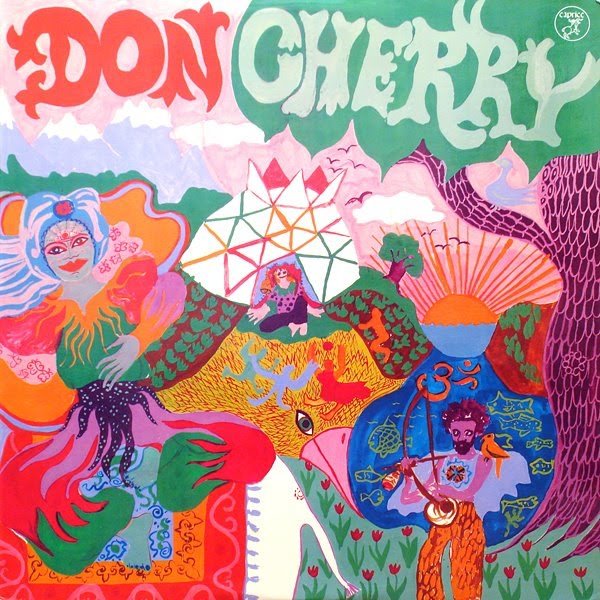It’s not entirely clear when trumpeter/multi-instrumentalist Don Cherry’s (1936-1995) organic-music cocktail of songs and traditions became a basis for an improvising language, but one can imagine that the thirst for knowledge went at least as far back as his Watts, Los Angeles bebop roots. By 1971 and 1972, when he convened the Organic Music Society sessions in Copenhagen, Bollnäs and Stockholm, Cherry had lived mainly in Europe for several years, in cities like Paris and Rome as well as a former schoolhouse in rural Sweden. His roots had grown broader and deeper through working with South African pianist Dollar Brand (Abdullah Ibrahim) and bassist Johnny Mbizo Dyani, Turkish drummer Okay Temiz and trumpeter Maffy Falay, and musicians from throughout Europe and the Americas. Added to this was the unique all-in scene available in Scandinavia, which allowed collaborations with composers, psychedelic musicians, jazzmen, visual artists, and filmmakers.
Released on the Swedish imprint Caprice, Organic Music Society joined Cherry with, among others, Falay, Temiz, percussionists Bengt Berger, Christer Bothén and Nana Vasconcelos, reedman Tommy Koverhult, a youth orchestra, and his wife Mocqui (whose tapestry design also graces the cover) on a patchwork of compositions and improvisations. In addition to the trumpeter’s tunes, there are also covers of Brand, Terry Riley, and Pharoah Sanders across 80 minutes of music. Though Organic Music Society has been one of the most lauded titles in the Caprice catalog, it is only now with the recordings’ fortieth anniversary that they’re seeing a renaissance on disc.
Opening with “North Brazilian Ceremonial Hymn,” it’s pretty clear that this set is distant from the free jazz milieu to which Cherry’s name is often attached. Girded by tanpura, berimbau, and bells (itself a fairly odd instrumental combination), the twelve-person chorus elicits a solemn, dirge-like processional in a field of accents. It’s unsettling but strangely peaceful music once one gives oneself over, washing away the particularities of tradition for another sort of ritual. The next four tracks are from the Cherry-Bothén-Berger session, mixing meditative fragments with chanting exhortations and churning modal repetition, though the trio tends to cycle through shifts rather abruptly on just the right side of ragtag. From a conversation this writer had with German vibraphonist Karl Berger (who worked frequently with Cherry), it became clear that the musicians had to recognize Cherry’s cues and follow him wherever his pied-piper intuition took the music, even as it crossed perceived sonic boundaries. On “Relativity Suite” he states that “this is the way of the organic society – to flow with time,” while incorporating tabla rhythms and Gnawa strings into a surging, ring-like ensemble vibration. It’s a rather different iteration of concepts that Cherry used with the Jazz Composers Orchestra for the 1973 JCOA LP of the same name.
The 1971 recordings from Stockholm’s Modernamuseet include nearly 30 minutes of music featuring Cherry’s voice, piano, and pocket trumpet with an ensemble of brass, flutes, bass, and percussion, balanced between a distant din and incisive clarity. Moving from minimalist arpeggios to the soaring “Desireless” (here titled “Hope”) and its piercing carpet, the ensemble sounds considerably larger than a sextet, able to engender hazily blissful visions and raw energy with equal measure. Cherry’s pianism is gorgeous and rhapsodic, a weighty arranger’s piano redolent of township barrelhouse and Monkish poise. Though hard to find, a similar vibe permeates the Stockholm free jazz orchestra Movement Incorporated (ostensibly led by Cherry) as well as reedman Gunnar Lindquist’s G.L. Unit (Odeon, 1970). A snatch of Brubeck precedes the group’s journey into “The Creator has a Master Plan,” which takes shape as several different song fragments before the familiar theme emerges. While Organic Music Society might seem at first like a disjointed (albeit spirited) smattering of improvisation and ethnographic reference, the music here is really something all its own, not only a cornerstone of Cherry’s unending journey, but also a bridging of world vanguards.
